Orwell Chess
by Glenn Overby
Introduction
Orwell Chess is a large chess variant for three players. It was designed as an entry for The Chess Variant Pages, in their 7th anniversary contest for games played on a board of 84 spaces. (My other official entry was Beastmaster Chess.)
The game uses seven piece types drawn from chess forms of different times and places all over the world. It also features a cylindrical board, with rank 1 and rank 12 adjacent to each other. This preserves symmetry for three players while retaining the familiarity of a grid of squares.
Finally, the game introduces an element of chance in the form of two dice. While dice chess fell out of favor over the centuries, it was sometimes practiced historically.
Setup
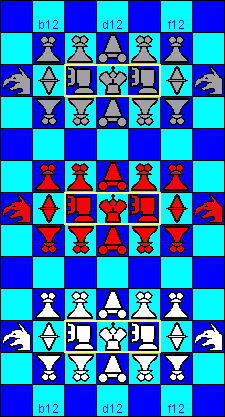
Orwell Chess board and pieces at start
(Most piece pictures from David Howe's Alfaerie font, used by permission.
Size reductions by Glenn Overby.)
Pieces
Berlinpeono
The Berlinpeono (no symbol) is a Berolina pawn, or reverse pawn. It was invented in 1926 in Europe for fairy chess problems. Each player starts with eight of these pieces, with four facing toward each opponent. White: b1, c1, e1, f1, b3, c3, e3, f3. Red: b5, c5, e5, f5, b7, c7, e7, f7. Black: b9, c9, e9, f9, b11, c11, e11, f11.
A Berlinpeono makes non-capturing moves of one square diagonally forward. It captures one square straight forward. Both moves are the exact opposite of the orthodox pawn. (In Orwell Chess, the Berlinpeono has no starting double-step.)
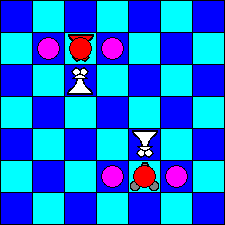
A Berlinpeono which enters any Minipax--the sets of three spaces occupied by Raja and two Paos at the start--promotes to a Dabbabah, Gryphon, Jugyo, or Pao.
The two sets of four Berlinpeonos for each player have a different forward direction, which is originally toward the nearest opponent. It continues with that forward direction around the entire cylinder. Using a pawn with a distinct facing is strongly recommended.
Dabbabah
The Dabbabah (symbol D), or war machine, was used in many old Islamic variants, with widely differing moves. This version comes from the game called Citadel Chess, or Shatranj al-Husun. Each player starts with two. White: d1, d3. Red: d5, d7. Black: d9, d11.
A Dabbabah moves like an orthodox bishop.
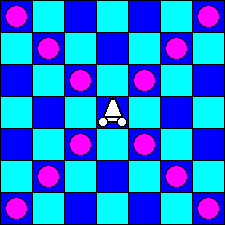
Dabbabahs are color-bound to dark squares only in Orwell Chess.
Gryphon
The Gryphon (symbol G), a mythical beast, comes from the Castilian variant Grande Acedrex, recorded in 1283. Each player starts with two. White: a2, g2. Red: a6, g6. Black: a10, g10.
A Gryphon moves one space diagonally, and may then continue outward either horizontally or vertically any number of unobstructed spaces.
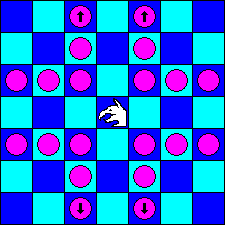
Gryphons cannot leap over other pieces, and must start their move with the one diagonal space.
Jugyo
The Jugyo (symbol J), or vertical mover, comes from the Japanese great chess variant Chu Shogi. Each player starts with two. White: b2, f2. Red: b6, f6. Black: b10, f10.
A Jugyo moves like an orthodox rook in the vertical direction only, or exactly one space horizontally.
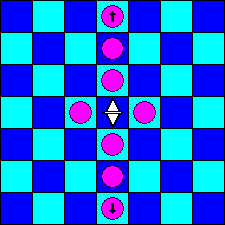
The Jugyo can circle the board vertically, since the end ranks are adjacent.
Pao
The Pao (symbol P), or cannon, comes from Xiangqi, or Chinese chess. Each player starts with two. White: c2, e2. Red: c6, e6. Black: c10, e10.
A Pao moves like an orthodox rook when not capturing. When capturing, it moves like a rook, leaping over exactly one piece of either player, and comes to rest on the next occupied space beyond, if that space is occupied by an opponent.
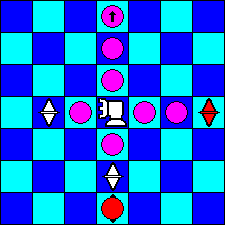
A Pao cannot capture by the ordinary means of landing on an opponent's square. A Pao cannot leap over another piece on a non-capturing move.
Raja
The Raja (symbol R) is the oldest chess king. He appears by that name, with the modern king's move, in the Indian game Chaturanga, which is the first recorded form of chess. White: d2. Red: d6. Black: d10.
Rajas may not capture other Rajas (or Maharajas).
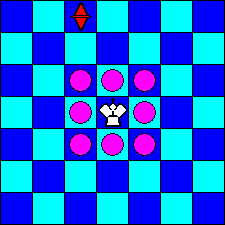
In Orwell Chess, just as in four-player Chaturanga, a Raja may move into check, and may be left in check. (After all, the dice may not let him die!)
Maharaja
The Maharaja (symbol M) comes from the 19th century game The Maharaja and the Sepoys, where he takes on an entire ordinary chess army. There are no Maharajas on the board at start.
A Maharaja can move like an orthodox queen or knight. It may not capture a Raja or Maharaja.
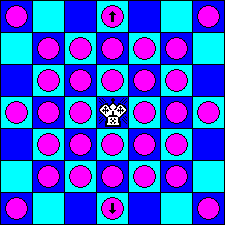
The Maharaja is treated like a Raja in all respects except for the increased movement. It comes into being when a player captures an opposing Raja or Maharaja (see rule 7 below).
Rules
- Turn Order: White plays first, then Red, then Black.
- Around the World: The board is cylindrical. Ranks 1 and 12 are adjacent to each other. For example, in the initial setup White can move a Dabbabah from d1 to capture at b11 or f11. A Berlinpeono moving to rank 12 simply transfers to the same space at the other end, and continues moving top-to-bottom or bottom-to-top as it did before.
- Dice: On each turn, the player throws two ordinary dice. The player moves pieces corresponding to the result. Each die corresponds to one piece; the same piece may move twice if both rolls permit. (If the player has no piece of a type rolled, that die is wasted.) A player must move if possible, and may move with either die first. A player's first move may leave a second move impossible. 1 or 6=Berlinpeono, Raja, or Maharaja; 2=Dabbabah; 3=Gryphon; 4=Jugyo; 5=Pao.
- Shifting Alliances: A player must alternate captures between opponents. (Exception: A player may always capture a Raja or Maharaja.) For example, if White's first capture is a Red piece, his second must be a Black piece, and so on in alternation.
- No Check: A Raja or Maharaja may be moved into check, or left in check. The dice provide the possibility that a royal piece en prise will not die immediately.
- Perpetual Power: When a Raja or Maharaja is captured, the capturing piece is promoted to Maharaja. There are always three royal pieces on the board.
- Game End: There are two ways to win. If one player controls all three royal pieces (either three Maharajas, or two Maharajas and a Raja), they win. Or, if one player is reduced to a single piece, the player making that capture wins.
- The following added differences exist from orthodox chess. Castling does not exist (no rooks). En passant captures do not exist (no double-step moves). Stalemate does not exist (dice sometimes compel a player to pass a move). Checkmate does not exist (see rules 5 and 6 above).
Sample Game
By anonymous playtesters Washington, Mao, and Napoleon.
| Move | White: Washington | Red: Mao | Black: Napoleon |
| 1 | 1,3 c3-d4, pass |
2,5 Dd7xf9, Pc6xc2 |
4,2 Jf10xf9, Dd11xf1 |
| 2 | 5,4 Pe2xc2, Jf2xf1 |
1,3 f7-g8, Gf6xf9 |
3,6 Gg10xf9, e11-d12 |
| 3 | 6,6 d4xd5, d5xd6=M |
5,3 Pe6xe3, pass |
6,5 d12xd1, Pe10xe3 |
| 4 | 1,1 Rd2xe3, Md6xf6 |
1,5 b7-c8, pass |
3,4 Gf9xg2, pass |
| 5 | 2,2 Dd3-e2, De2xd1 |
4,2 Jb6xb9, pass |
1,5 c9xc8, Pc10xc1 |
| 6 | 4,4 Jf1-g1, Jg1xg8 |
3,6 Ga6-b7, f5-e4 |
3,2 Ga10xb9, Dd9-e10 |
| 7 | 2,1 Dd1xb11, Mf6xe4 |
1,4 e5xe4=M, pass |
4,6 Jb10xb11, c8xc7 |
| 8 | 6,3 b1-c12, Ga2xc1 |
4,4 pass, pass |
2,2 De10xg8, Dg8-d5 |
| 9 | 3,6 Gc1xd10=M, Md10-d4 |
6,5 Me4xd5, pass |
2,2 pass, pass |
| 10 | 6,5 Md4xb5, Pc2xc7 |
6,4 Md5xc7, pass |
4,2 Jb11xa11, pass |
| 11 | 5,5 pass, pass |
1,1 Mc7xb9, Mb9xb2 |
4,6 Ja11-b11, f11-g12 |
| 12 | 5,4 pass, pass |
2,5 pass, pass |
3,1 Gg2-f8, g12-f1 |
| 13 | 3,3 pass, pass |
1,6 Mb2xb11, Mb11xb3 |
3,6 Gf8xe7, c11xc12 |
| 14 | 6,1 Mb5xb7, Mb7xe7 |
1,2 Mb3-f11, pass |
6,2 f1-e2=J, pass |
| 15 | 6,4 Me7xc5 [1:0:0] |
Notes
About the Theme
I have been considering a three-player variant for some time. When the contest on an 84-square board was announced, I thought about the classic novel 1984 by George Orwell, with its three main powers Eurasia, Eastasia, and Oceania in constant ebb-and-flow.
In choosing a pseudo-Orwellian model, several design features (in addition to three players) were picked to support the theme.
The board allows an around-the-world movement.
The pieces are drawn from all around the world of chess. (The name Berlinpeono is a one-word Esperanto translation of Berlin pawn. The name Jugyo is my own understanding of the two Japanese kanji, and differs from other published sources.)
The Shifting Alliances rule reflects the ongoing two-versus-one shifts of 1984.
The Perpetual Power rule, always keeping three Rajas (or Maharajas) in play, mimics the implied perpetual nature of the three main power blocs. (Make no mistake--hunting the Raja is critical and carries real advantages, even though a player is not eliminated by losing their Raja as in orthodox chess. His royalty is just expressed differently.)
About Three-Player Games
Three-player chess games suffer from two common problems. The first is an asymmetrical starting position. The second is petty diplomacy with two players ganging up on the third.
The starting position issue was solved by making the board a cylinder, with a number of ranks divisible by three. Each player can now start in exactly the same position relative to each other player.
The petty diplomacy problem was attacked with a combination of rules. Dice limit the ability to move pieces freely to gang up on someone. The Shifting Alliances rule requires would-be allies to beat up on each other much of the time. And the Perpetual Power rule keeps the victim of misfortune around for revenge.
About the Dice
Players accustomed to orthodox chess sometimes find dice disconcerting. The complaint is that there is too much luck involved. Sometimes it's true. But good players make their own luck.
If one of your pieces is vulnerable to capture, your opponent can hit it 11 times out of 36 with most pieces, 5 times out of 9 if the would-be capturer is a Berlinpeono or Raja. The double-move by a Berlinpeono or Raja happens once out of nine rolls.
A player who loses both pieces of one type will also waste one-sixth of their dice from that point on (unless they can promote a Berlinpeono). This is often more important than the raw value of the piece.
More Tips
The Gryphon is the most dangerous ordinary piece, with an unusual and effective way of forking pieces. It is reminiscent of Knight forks at a distance.
There is a difference between light and dark squares. The dark squares are patrolled by Dabbabahs generally absent from the light squares.
Open files are important in this game, with the potential for circling the board in that direction. Three standard pieces, plus the Maharaja if earned, exploit this direction of long-range movement. Berlinpeonos also tend to open files quickly.
Leaving hanging pieces is unavoidable. If you leave them vulnerable to a player whose last capture was against you, it's a little safer.
Keep both players under threat, even if you are concentrating on one. You can only sustain your attack by interweaving captures against the third player, or by attacking a royal piece repeatedly.
The early game is dominated by lots of capturing, as the piece density is unusually high. Dabbabahs are at their best early on, while Paos and Jugyos become more important in the middle game. As the board empties out, Gryphons and Maharajas take center stage, commanding up to 32 or 37 squares respectively. A player with either or both in the endgame has a large advantage.
Acknowledgements
Thank you, many times over, to long distance playtesters Peter Aronson and Tony Quintanilla, and local playtesters William Bartlomiej, John Padavan, and Zillions of Games. I couldn't have done it without you.
Computer Play
If you have Zillions of Games installed on your computer, you can play this game. Download file: orwellzog.zip.Copyright © 2002 by Glenn E. Overby II. This is an entry in a contest of The Chess Variant Pages, and is used there by permission. All rights reserved.
Written by Glenn Overby II.
WWW page created: September 23, 2002.
